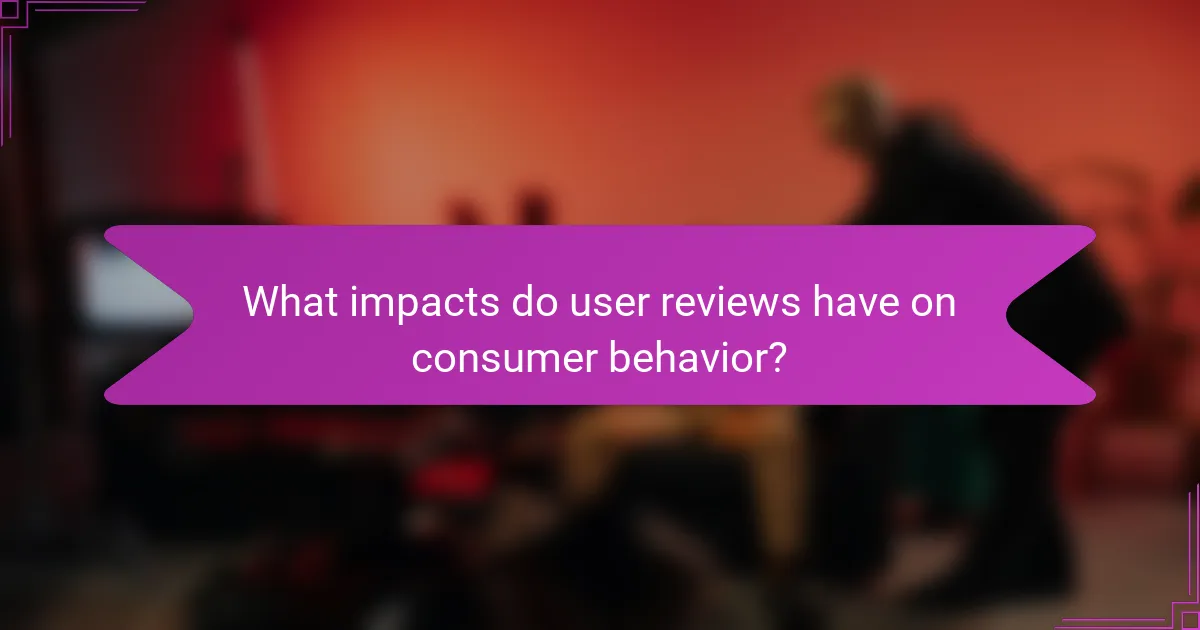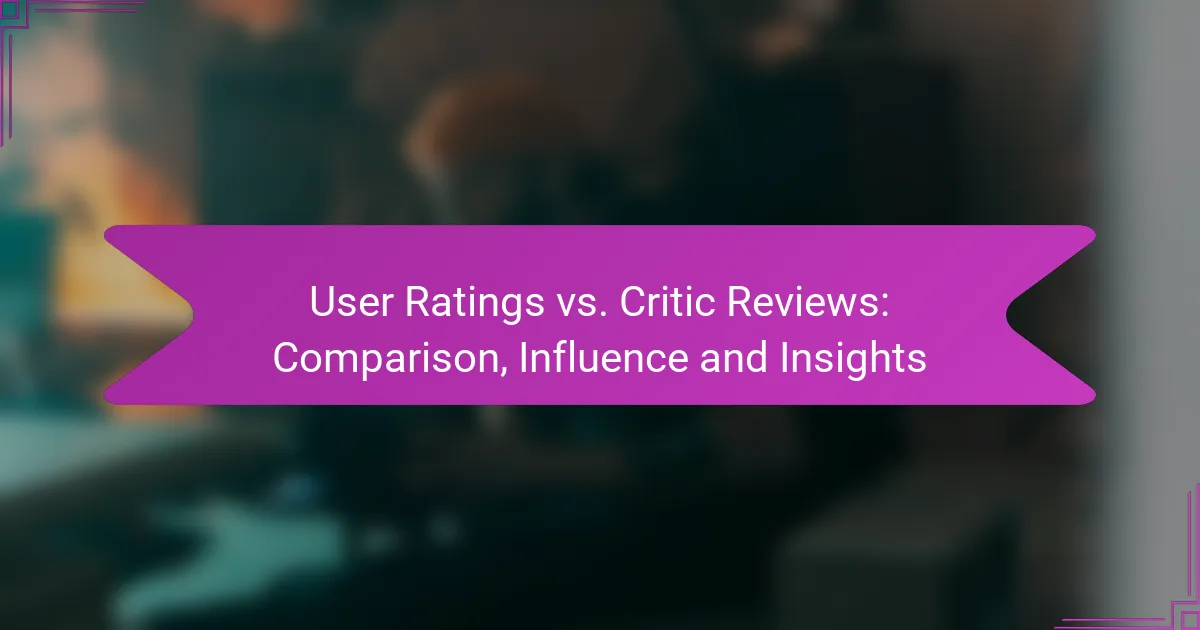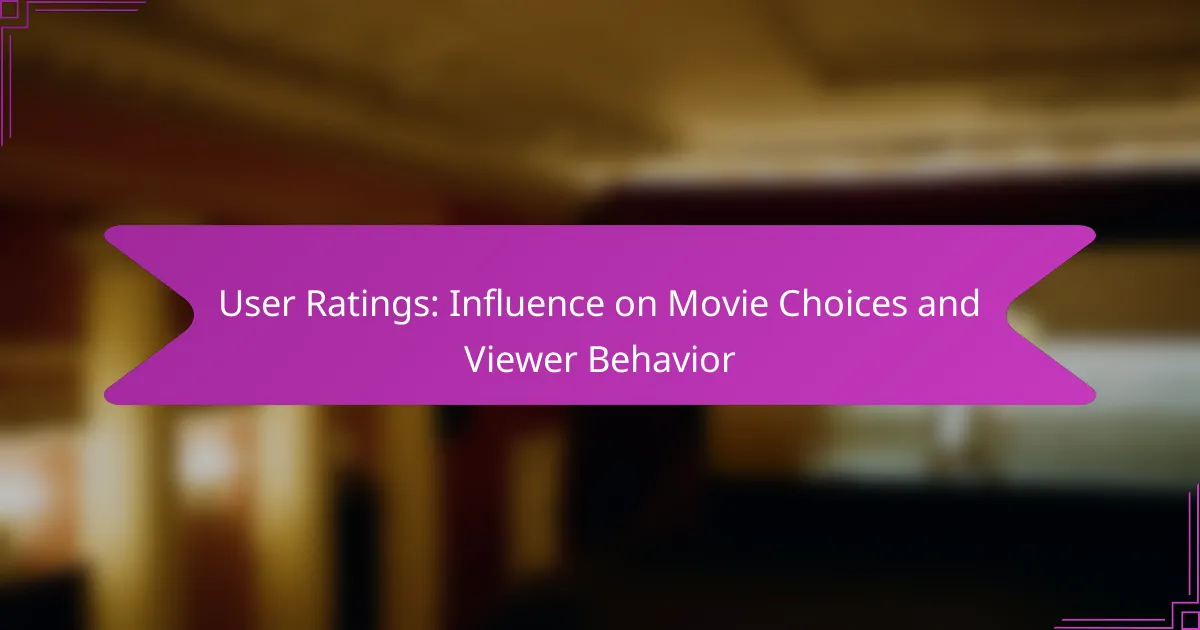User reviews and critic reviews serve distinct purposes in shaping consumer perceptions. While user reviews reflect personal experiences and opinions, critic reviews provide a structured analysis from industry experts. These differences not only affect how each review is perceived but also influence purchasing decisions and brand loyalty among potential buyers.

How do user reviews differ from critic reviews?
User reviews are based on individual experiences and opinions, while critic reviews offer a more structured analysis from industry professionals. These differences impact how each type of review is perceived and utilized by potential consumers.
User reviews reflect personal experiences
User reviews are subjective and often highlight personal encounters with a product or service. They can vary widely, as different users prioritize different aspects, such as price, usability, or customer service. For instance, one user may rave about a restaurant’s atmosphere while another focuses on the food quality.
These reviews typically appear on platforms like Yelp or Amazon, where users can rate their experiences on a scale, often from one to five stars. The sheer volume of user reviews can provide a broader understanding of a product’s performance, but they may lack consistency and depth.
Critic reviews provide expert analysis
Critic reviews are crafted by professionals who analyze products or services based on established criteria and industry standards. These reviews often include detailed evaluations of features, performance, and value for money, making them a reliable source for consumers seeking informed opinions.
Critics may publish their reviews in newspapers, magazines, or dedicated websites, often using a standardized rating system. For example, a film critic might assess a movie based on direction, acting, and cinematography, providing a comprehensive overview that can guide viewers in their choices.

What impacts do user reviews have on consumer behavior?
User reviews significantly influence consumer behavior by shaping perceptions and guiding purchasing decisions. They provide insights into product quality and user satisfaction, which can either encourage or deter potential buyers.
User reviews influence purchasing decisions
User reviews play a crucial role in the purchasing process, often swaying consumers toward or away from a product. Research indicates that a majority of shoppers consult reviews before making a purchase, with many considering them as trustworthy as personal recommendations.
For example, a product with a high rating and numerous positive reviews is likely to attract more buyers than one with few or negative reviews. Consumers often look for products with at least four stars to feel confident in their choices.
User reviews enhance brand trust
Positive user reviews can significantly enhance a brand’s trustworthiness. When potential customers see consistent praise for a brand’s products or services, they are more likely to feel secure in their purchasing decisions.
Conversely, negative reviews can damage a brand’s reputation, leading to decreased sales. Brands should actively manage their online presence and respond to reviews to maintain trust and demonstrate commitment to customer satisfaction.

What impacts do critic reviews have on consumer behavior?
Critic reviews significantly influence consumer behavior by shaping perceptions and guiding purchasing decisions. Positive reviews can enhance interest and trust, while negative reviews may deter potential buyers, impacting sales and brand loyalty.
Critic reviews shape industry standards
Critic reviews often set benchmarks for quality within an industry. When a critic highlights specific features or performance aspects, it can lead to a shift in consumer expectations and compel companies to improve their offerings to meet these standards.
For example, in the film industry, a movie receiving high praise for its cinematography may prompt other filmmakers to invest more in visual storytelling. This ripple effect can elevate overall production quality across the board.
Critic reviews affect brand reputation
The reputation of a brand can be heavily influenced by critic reviews, especially in competitive markets. A well-regarded critic’s endorsement can elevate a brand’s status, while scathing reviews can tarnish its image, leading to decreased sales and customer trust.
For instance, a restaurant that receives a glowing review from a prominent food critic may see a surge in reservations, while a negative review could result in a significant drop in patronage. Brands must actively manage their public relations to mitigate the impact of unfavorable critiques.

How do user reviews and critic reviews complement each other?
User reviews and critic reviews serve distinct but complementary roles in evaluating products, services, or media. User reviews provide a broad range of personal experiences, while critic reviews offer expert analysis and contextual understanding, helping consumers make informed decisions.
User reviews offer diverse perspectives
User reviews reflect the opinions of everyday consumers, capturing a wide array of experiences and preferences. This diversity allows potential buyers to see how a product performs in real-world situations, which can vary significantly from one individual to another.
For example, a video game might receive mixed user reviews, with some praising its graphics and others criticizing its gameplay. This range of feedback helps users gauge whether a product aligns with their specific tastes and expectations.
Critic reviews provide depth and context
Critic reviews are typically written by professionals with expertise in a particular field, offering insights that may not be apparent in user reviews. These reviews often analyze elements such as quality, design, and performance, providing a more nuanced understanding of a product.
For instance, a film critic might evaluate the cinematography, direction, and script, giving readers a comprehensive view of the film’s artistic merits. This depth can help consumers appreciate aspects of a product that they might overlook based on user feedback alone.

What are the best platforms for user and critic reviews?
The best platforms for user and critic reviews vary by industry, with specific sites catering to different types of products and services. Choosing the right platform can significantly influence consumer decisions and brand reputation.
Yelp for local businesses
Yelp is a leading platform for user reviews of local businesses, particularly restaurants and service providers. Users can leave ratings and detailed comments, helping others make informed choices based on real experiences.
When using Yelp, businesses should actively manage their profiles by responding to reviews and updating information. This engagement can enhance their reputation and attract more customers. However, businesses should be cautious of negative reviews and address them professionally to mitigate potential damage.
Rotten Tomatoes for movies
Rotten Tomatoes specializes in movie reviews, aggregating critic and user ratings to provide a comprehensive score for films. The site features a “Tomatometer” that reflects the percentage of positive reviews from critics, alongside audience scores based on user feedback.
For moviegoers, Rotten Tomatoes offers a quick way to gauge a film’s reception before watching. However, users should consider that critic opinions may not always align with personal taste. It’s beneficial to read a mix of critic and user reviews to get a balanced perspective on a film’s quality.

How can businesses leverage user and critic reviews?
Businesses can effectively leverage user and critic reviews to enhance their reputation, improve products, and increase customer engagement. By actively seeking feedback and responding to reviews, companies can build trust and foster loyalty among their audience.
Encourage user feedback
Encouraging user feedback is essential for businesses aiming to improve their offerings. Simple strategies include sending follow-up emails after purchases, offering incentives like discounts for reviews, or creating easy-to-use feedback forms on websites. These methods can significantly increase the volume of user-generated feedback.
To maximize the impact of user reviews, businesses should ensure that the feedback process is straightforward and accessible. Providing clear instructions and minimizing the time required to leave a review can lead to higher participation rates. Aim for a balance between quantity and quality of feedback.
Engage with critic reviews
Engaging with critic reviews allows businesses to gain insights from industry experts and enhance their credibility. Responding to critic reviews, whether positive or negative, demonstrates that a business values professional opinions and is committed to improvement. This engagement can also attract potential customers who trust expert evaluations.
When responding to critic reviews, it is crucial to maintain professionalism and address any concerns raised. Acknowledge positive feedback and express gratitude, while also providing constructive responses to negative critiques. This approach not only shows respect for the critic’s viewpoint but also highlights a business’s willingness to adapt and grow.

What are the challenges of managing user and critic reviews?
Managing user and critic reviews involves navigating diverse opinions and expectations, which can significantly impact reputation and sales. Key challenges include addressing negative feedback and ensuring the authenticity of reviews, both of which require careful strategies to maintain credibility and customer trust.
Addressing negative feedback
Negative feedback can deter potential customers and damage a brand’s reputation. It’s crucial to respond promptly and professionally to such reviews, acknowledging the issues raised and offering solutions or apologies where appropriate.
Consider implementing a structured response strategy that includes monitoring reviews regularly, categorizing feedback, and prioritizing responses based on severity. For instance, a quick acknowledgment of a minor complaint can show attentiveness, while a detailed response to a significant issue can demonstrate commitment to customer satisfaction.
Ensuring authenticity of reviews
Authenticity is vital for maintaining trust in reviews. Users are more likely to rely on genuine feedback from other customers than on promotional content. To ensure authenticity, businesses can encourage verified purchases to leave reviews and utilize third-party platforms that authenticate user identities.
Additionally, consider implementing a review moderation process that filters out spam or fake reviews. This can include looking for patterns in review language or checking for inconsistencies in user profiles. Transparency about how reviews are collected and displayed can also enhance credibility.

What emerging trends are shaping user and critic reviews?
Emerging trends in user and critic reviews are increasingly influenced by technology, particularly social media and online platforms. These trends are reshaping how feedback is shared and perceived, affecting consumer decisions and brand reputations.
Influence of social media on reviews
Social media platforms have transformed the landscape of reviews, allowing users to share their opinions instantly and widely. This immediacy can amplify both positive and negative feedback, making it crucial for brands to monitor their online presence actively.
Platforms like Twitter, Instagram, and Facebook enable users to post reviews that can reach thousands within minutes. For instance, a viral post about a product can lead to a surge in sales or a significant drop in reputation, depending on the sentiment expressed.
Brands should engage with users on these platforms, responding to reviews and addressing concerns promptly. This proactive approach can enhance customer loyalty and mitigate potential damage from negative reviews. Regularly analyzing social media feedback can provide valuable insights into consumer preferences and emerging trends.



